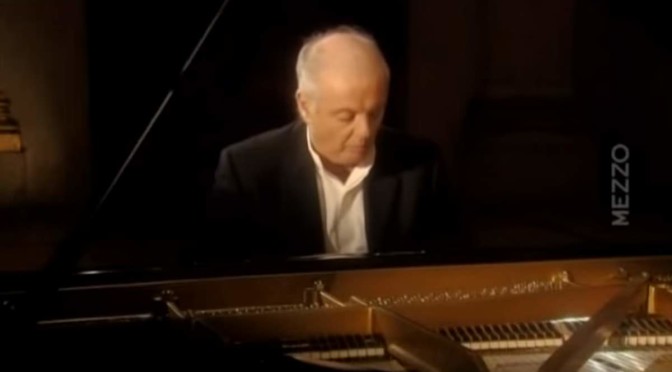Daniel Barenboim plays Ludwig van Beethoven’s Piano Sonata No. 26 in E-flat major, Op. 81a, also known as the Les Adieux sonata.
Beethoven’s Piano Sonata No. 26 “Les Adieux”
Beethoven’s Piano Sonata No. 26 was written between the years 1809 and 1810. The French attack on Vienna, led by Napoléon Bonaparte in 1809, forced Beethoven’s patron, Archduke Rudolph (8 January 1788 – 24 July 1831, a Cardinal, an Archbishop of Olmütz), to leave the city.
Yet, there is some uncertainty about the nature of the piece – or at least, about the degree to which Beethoven wished this programmatic nature would be known. He titled the three movements “Lebewohl,” “Abwesenheit,” and “Wiedersehen,” and reportedly regarded the French “Adieux” (said to whole assemblies or cities) as a poor translation of the feeling of the German “Lebewohl” (said heartfully to a single person) (Kolodin, 1975). Indeed, Beethoven wrote the syllables “Le-be-wohl” over the first three chords.
In the first 1811 publication, a dedication was added reading “On the departure of his Imperial Highness, for Archduke Rudolph in admiration”.
Three movements of Beethoven’s Piano Sonata No. 26 were originally written in German and French, and the last two movements are described in German because of the unusual tempo.
- Das Lebewohl (Les Adieux – The Farewell): Adagio – Allegro. The first movement is characterized by its expressive depth, reflecting the emotions of parting. Beethoven integrates a motif representing the word “Lebewohl” (farewell), using descending notes to evoke a sense of farewell, blending poignancy with the innovative sonata form.
- Abwesenheit (L’Absence – The Absence): Andante espressivo (In gehender Bewegung, doch mit viel Ausdruck – In walking motion, but with much expression). The second movement captures the feeling of longing and melancholy during separation. This movement is marked by its lyrical tenderness and expressive nuances, with a contemplative melody that conveys a sense of yearning. Beethoven’s use of minor tonalities and delicate dynamics reflects the emotional landscape of absence, creating a deeply introspective and poignant musical expression.
- Das Wiedersehen (Le Retour – The Return): Vivacissimamente (Im lebhaftesten Zeitmaße – The liveliest time measurements). The finale bursts with joyful energy, celebrating a reunion. Marked Vivacissimamente, it features exuberant rhythms and uplifting melodies, symbolizing the happiness of return. Beethoven masterfully contrasts the previous movements’ sentiments with this finale, using vibrant passages and dynamic contrasts to convey a triumphant and heartfelt welcome, culminating the sonata on an optimistic note.
Sources
- Piano Sonata No. 26 (Beethoven) on Wikipedia
- Piano Sonata No. 26 in E-flat major, Op. 81a, “Les Adieux” on the Los Angeles Philharmonic Orchestra’s official website
- Ivo Pogorelić plays Beethoven’s Für Elise - July 25, 2024
- Telemann: Concerto for Recorder and Viola da Gamba [Bremer Barockorchester] - July 23, 2024
- Gershwin: Rhapsody in Blue [Lang Lang] - July 21, 2024



Your changes to the system have made it impossible to get anything to play. Appreciat3e the music, but you need to fix this problem.